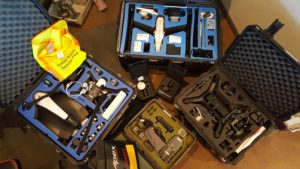
A guest post by Embry Riddle Aeronautical University. The unmanned aircraft systems (UAS) market has seen strong growth in recent years as new applications continue to be discovered. Industries such as agriculture, construction and real estate have broadened their use of drone technology in what’s predicted to become a $13 billion investment for business and civil government by 2020.
“With the ever expanding use of unmanned aircraft evident, the UAS industry seems to be at a precipice of commercial development regarding drone usage for inspections,” said Scott Burgess, Ph.D., a drone inspection course instructor and faculty member at Embry-Riddle Aeronautical University – Worldwide.
“In the past, drones were best known for military applications, but in recent years they’ve become increasingly used for commercial and emergency services.”
 Drones were widely used before and after hurricanes Harvey, Irma and Maria. From news coverage to insurance inspections, this technology allowed organizations across numerous industries to quickly and safely assess and inspect storm damage.
Drones were widely used before and after hurricanes Harvey, Irma and Maria. From news coverage to insurance inspections, this technology allowed organizations across numerous industries to quickly and safely assess and inspect storm damage.
Insurance companies like Allstate and USAA used drones for inspections during hurricane recovery efforts to save both time and money – benefiting insurers and policyholders alike. Drones also ensured the safety of adjusters and inspectors and allowed for quicker, more frequent inspections. Power companies such as Florida Power and Light and Jacksonville (Fla.) Electric Authority also used drones to assist with crew safety while restoring power in the aftermath of the storms.
“Currently, the energy sector seems to be the largest consumer of drone inspections,” he said. “However, there is no doubt the insurance industry is an ideal candidate for the future.”
While drone inspections have become an incredible asset to organizations, Burgess also acknowledged potential challenges and concerns related to this emerging technology.
“Inspections are a sensitive subject with several ethical elements involved,” he said. “For example, a drone flying over a home for a roof inspection in a confined neighborhood could raise concerns about the neighbors’ right to privacy. The use of unmanned aerial vehicles to inspect power lines could cause apprehension since some aircraft fly beyond visual line of sight.”
These issues prompted the Federal Aviation Administration (FAA) to develop guidelines in 2016. However, the rules are subject to waiver and can present significant issues for commercial operators. The FAA will continue to explore these issues with its upcoming UAS Integration Pilot Program.
Regardless of the application, all drone users must be committed to safety. Without properly trained operators, drones can cause property damage or injury to humans during assessments. Unsafe operation creates liability issues and also negatively impacts the industry as a whole by increasing risk, Burgess said.
“Ensuring that an organization’s crew is proficient in drone operation leads to enhanced efficiency and economic success,” he explained.
Learn more about conducting drone safety inspections through Embry-Riddle’s Office of Professional Education. The next sUAS Inspection course begins Jan. 8. Led by Burgess, the four-week online inspection course provides an entry-level understanding of the concepts required for various kinds of drone inspections. Topics include an introduction to inspection types, flight operations, data collections and sUAS regulations. Additionally, the course discusses safety, flight planning, data collection and processing, maintenance and communications, which are essential to conducting safe and effective inspections. For more information, visit proed.erau.edu.
Alan is serial entrepreneur, active angel investor, and a drone enthusiast. He co-founded DRONELIFE.com to address the emerging commercial market for drones and drone technology. Prior to DRONELIFE.com, Alan co-founded Where.com, ThinkingScreen Media, and Nurse.com. Recently, Alan has co-founded Crowditz.com, a leader in Equity Crowdfunding Data, Analytics, and Insights. Alan can be reached at alan(at)dronelife.com







[…] Source link […]